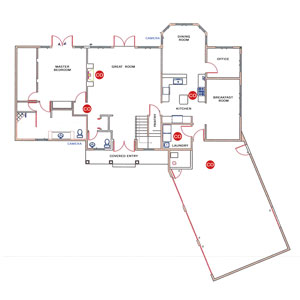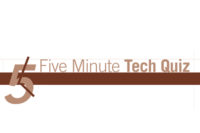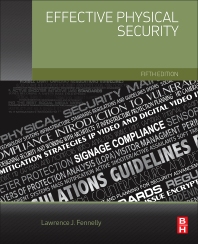1. Carbon monoxide is heavier than air, and that’s why the detector can be plugged into a wall outlet just above the floor level.
a) True
b) False
2. Potential sources of carbon monoxide are
a) wood-burning stoves.
b) automobile exhaust.
c) furnaces.
d) barbeques or grills.
e) All of the above
3. What is an acceptable mounting location for a carbon monoxide detector?
a) Near the ceiling
b) Plugged into an outlet
c) 5 to 6 feet above the floor
d) Any of the above
4. Water detectors are always mounted on the floor.
a) True
b) False
5. In a residential application, you always should install carbon monoxide detectors
a) in an attached garage.
b) directly above all fireplaces.
c) in the kitchen with gas appliances.
d) All of the above
e) None of the above
6. Carbon monoxide, gas detectors and water sensors
a) are all the same so they can be wired to the same zone.
b) must be wired to different zones because the emergency response is different.
c) are only activated when the system is armed to avoid false alarms.
d) are devices not installed by burglar alarm companies.
7. Flame detectors are also considered to be “environmental” detectors.
a) True
b) False
8. High and low temperature alarms are not acceptable for
a) refrigeration units.
b) computer rooms.
c) flower shops.
d) fire alarm activation.
e) Any of the above
9. Which code specifies requirements for carbon monoxide alarms?
a) 70
b) 72
c) 720
d) 731
e) UL 681
10. Carbon monoxide detectors should be
a) tested every year and replaced after three years.
b) tested after installation, then alternate years, and must be replaced after 10 years, according to manufacturers’ instructions.
c) tested at installation and replaced after five years.
d) tested at installation, every year thereafter, and replaced between five and six years after installation, depending upon manufacturers’ instructions.
11. Match the symptoms of the concentration of CO exposure
a) 200ppm
b) 800ppm
c) 1000ppm
d) 1600ppm
1. Loss of consciousness after 1 hour.
2. A headache, nausea and dizziness after 20 minutes.
3. Mild headache after 2-3 hours.
4. Headache, nausea and dizziness after 45 minutes of exposure, and unconsciousness after 2 hours.
12. Ammonia, CO, and methane gas detectors all should be mounted
a) up high.
b) down low.
c) It doesn’t matter.
d) Each one has different requirements.
13. Water detectors are used for
a) detecting leaks in roofs.
b) detecting high humidity that causes condensation.
c) detecting overflowing sump pumps.
d) None of the above
What’s Wrong With This?
An alarm technician installed a security system for a residential customer that included several carbon monoxide detectors. The detectors activated for no reason causing false alarms. The detectors were wired to their own zone and reported a carbon monoxide (CO) alarm to the monitoring station. They were programmed for a 24-hour zone. Can you see what the technician did wrong?

|
Answer to: What’s Wrong With This?
The alarm technician placed the detectors in all the wrong locations. The garage is not the right location for a detector due to excessive car exhaust. The living room was not the correct location because he placed it directly over the fireplace. The kitchen and laundry room had gas appliances. The only correctly placed detector was just outside the bedroom. The technician could have installed a detector inside the master bedroom as well if he wanted.

|
5-Minute Tech Quiz Answers
Here are the answers to 5-Minute Tech Quiz.
1) b — Carbon monoxide is slightly lighter than air, but mixes with air currents allowing it to be mounted up high or low.
2) d
3) d
4) b
5) e — Placing a detector too close to the source of potential gases could cause false alarms. They should be placed on every level of a home or in between the potential source and sleeping areas.
6) b
7) b — They are considered fire detection devices.
8) d — Fire code mandates fire alarm devices be listed for such use.
9) c
10) d
11) (A, 3) (B, 4) (C, 1) (D, 2)
12) d
13) c







